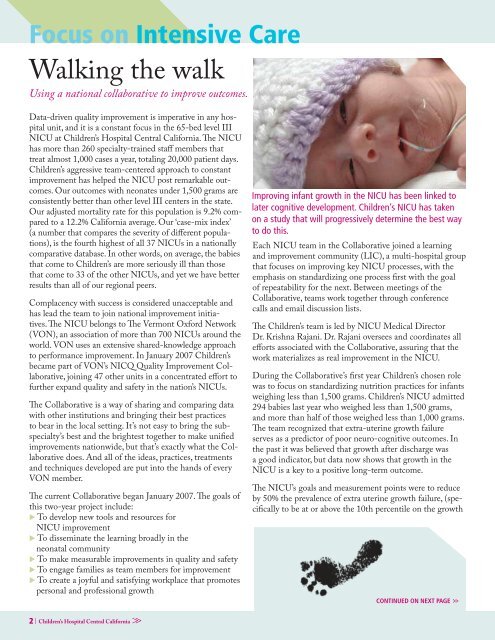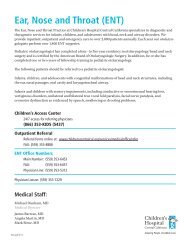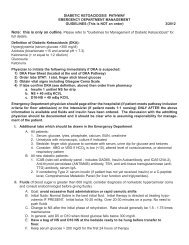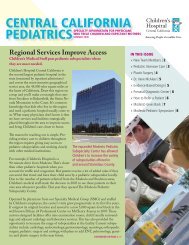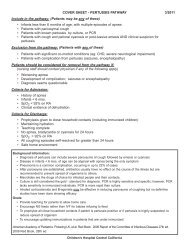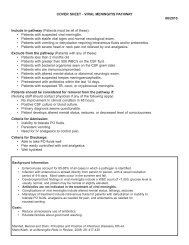CENTRAL CALIFORNIA PEDIATRICS - Children's Hospital Central ...
CENTRAL CALIFORNIA PEDIATRICS - Children's Hospital Central ...
CENTRAL CALIFORNIA PEDIATRICS - Children's Hospital Central ...
You also want an ePaper? Increase the reach of your titles
YUMPU automatically turns print PDFs into web optimized ePapers that Google loves.
Focus on Intensive Care<br />
Walking the walk<br />
Using a national collaborative to improve outcomes.<br />
Data-driven quality improvement is imperative in any hospital<br />
unit, and it is a constant focus in the 65-bed level III<br />
NICU at Children’s <strong>Hospital</strong> <strong>Central</strong> California. The NICU<br />
has more than 260 specialty-trained staff members that<br />
treat almost 1,000 cases a year, totaling 20,000 patient days.<br />
Children’s aggressive team-centered approach to constant<br />
improvement has helped the NICU post remarkable outcomes.<br />
Our outcomes with neonates under 1,500 grams are<br />
consistently better than other level III centers in the state.<br />
Our adjusted mortality rate for this population is 9.2% compared<br />
to a 12.2% California average. Our ‘case-mix index’<br />
(a number that compares the severity of different populations),<br />
is the fourth highest of all 37 NICUs in a nationally<br />
comparative database. In other words, on average, the babies<br />
that come to Children’s are more seriously ill than those<br />
that come to 33 of the other NICUs, and yet we have better<br />
results than all of our regional peers.<br />
Complacency with success is considered unacceptable and<br />
has lead the team to join national improvement initiatives.<br />
The NICU belongs to The Vermont Oxford Network<br />
(VON), an association of more than 700 NICUs around the<br />
world. VON uses an extensive shared-knowledge approach<br />
to performance improvement. In January 2007 Children’s<br />
became part of VON’s NICQ Quality Improvement Collaborative,<br />
joining 47 other units in a concentrated effort to<br />
further expand quality and safety in the nation’s NICUs.<br />
The Collaborative is a way of sharing and comparing data<br />
with other institutions and bringing their best practices<br />
to bear in the local setting. It’s not easy to bring the subspecialty’s<br />
best and the brightest together to make unified<br />
improvements nationwide, but that’s exactly what the Collaborative<br />
does. And all of the ideas, practices, treatments<br />
and techniques developed are put into the hands of every<br />
VON member.<br />
The current Collaborative began January 2007. The goals of<br />
this two-year project include:<br />
To develop new tools and resources for<br />
NICU improvement<br />
To disseminate the learning broadly in the<br />
neonatal community<br />
To make measurable improvements in quality and safety<br />
To engage families as team members for improvement<br />
To create a joyful and satisfying workplace that promotes<br />
personal and professional growth<br />
Improving infant growth in the NICU has been linked to<br />
later cognitive development. Children’s NICU has taken<br />
on a study that will progressively determine the best way<br />
to do this.<br />
Each NICU team in the Collaborative joined a learning<br />
and improvement community (LIC), a multi-hospital group<br />
that focuses on improving key NICU processes, with the<br />
emphasis on standardizing one process first with the goal<br />
of repeatability for the next. Between meetings of the<br />
Collaborative, teams work together through conference<br />
calls and email discussion lists.<br />
The Children’s team is led by NICU Medical Director<br />
Dr. Krishna Rajani. Dr. Rajani oversees and coordinates all<br />
efforts associated with the Collaborative, assuring that the<br />
work materializes as real improvement in the NICU.<br />
During the Collaborative’s first year Children’s chosen role<br />
was to focus on standardizing nutrition practices for infants<br />
weighing less than 1,500 grams. Children’s NICU admitted<br />
294 babies last year who weighed less than 1,500 grams,<br />
and more than half of those weighed less than 1,000 grams.<br />
The team recognized that extra-uterine growth failure<br />
serves as a predictor of poor neuro-cognitive outcomes. In<br />
the past it was believed that growth after discharge was<br />
a good indicator, but data now shows that growth in the<br />
NICU is a key to a positive long-term outcome.<br />
The NICU’s goals and measurement points were to reduce<br />
by 50% the prevalence of extra uterine growth failure, (specifically<br />
to be at or above the 10th percentile on the growth<br />
CONTINUED ON NEXT PAGE >><br />
2 | Children’s <strong>Hospital</strong> <strong>Central</strong> California >>


